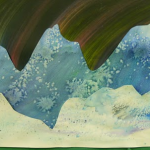In northern latitudes, the effect is known as the aurora borealis (also known as the northern lights), named after the Roman goddess of dawn, Aurora, and the Greek name for the north wind, Boreas, by Pierre Gassendi in 1621. Auroras seen near the magnetic pole may be high overhead, but from farther away, they illuminate the northern horizon as a greenish glow or sometimes a faint red, as if the Sun were rising from an unusual direction. [Source]
Answer the following questions after watching the video above. [Source]
- Observe: What colors seem to be most common in the northern lights displays?
- Describe: Use three word phrases to describe the different shapes you have seen?
- Create: What words or word phrases might you use to describe how the northern lights move or “dance” in the sky
- Guess: Do you think there is energy in the lights?
- Guess: What do you think they really are?
Read this quick explanation of the northern lights then:
- Were either of your guesses above correct?
- Write 8 facts from the page you just read.
Read Legends about the aurora borealis
- Write 4 facts from the page you just read.
- Make up your own explanation about where the aurora come from.
Create art like this using salt and pastels.

Norther Lights Art Project
The two videos below have relaxing, meditative music with images of the northern lights. Play this background music while working on the art project above.




 Please support this site by contributing to the coffee fund. All donations are appreciated.
Please support this site by contributing to the coffee fund. All donations are appreciated.